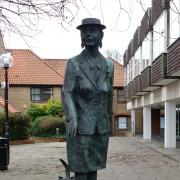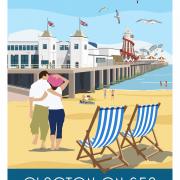Revd John N Merrill has a love for Essex and a love for walking, and 2018 marked a special celebration of an achievement that embraced both of these passions

In November 1978, after more than 6,600 miles of walking around the entire coastline of Britain, starting from St Paul’s Cathedral, I reached Manningtree and my last county before London. By this point in my walk I was back to short daylight hours and poor weather.
Nevertheless, one over-riding memory from the whole walk was waking up in my tent and seeing the sun rise above the salt marshes of Essex.
The Essex coastline is the second longest of any England county, more than 300 miles excluding its islands. I particularly enjoyed the remarkable solitude and remoteness of the Essex coast, and resolved even then that I would one day return and explore more fully this captivating coastline of hidden beauty.

To me Essex is like the west coast of Scotland in reverse – they are quite the yin and yang of Britain. Scotland is rugged, high mountains, numerous offshore islands, abundant with waders and sea birds, and remote.
There are many sea locks which take days to walk round, only to be opposite where you were a few days ago. Essex is also remote, as remote as anywhere in Britain.
It has numerous offshore islands, abundant sea birds and waders, but is basically flat and low lying, with numerous coastal river creeks which take days to walk round. The countryside, like Scotland, is lightly inhabited. And, like Scotland, you see few people.

Last year I decided to honour that resolution to myself and return to Manningtree and walk once more around the coastline to South Benfleet, some 300 miles.
I never expected the gap in time to be 40 years, although in between times I did frequently visit the Essex coast and walk sections or explore many of the islands.
My plan was to complete the walk over a few days, but due to work commitments and opportunities to walk other long distance paths abroad, I eventually spent a year walking it. This did have advantages, as I would see the coast in all seasons, but also meant that some days I would spend more hours travelling to where I left off than actually walking.

All sections were reached by either train or bus and everyone was most helpful. One bus driver to Bradwell Waterside even went off route to deposit me at the stile where I had walked inland for the bus a few days before!
Essex is undervalued and often dismissed as not good walking country, but this is an unsubstantiated myth.
The salt-marshes and rivers have a hypnotic beauty and when I had completed the walk I felt a great loss that I was not walking the sea wall anymore or able to enjoy the remote locations.

Once more I have resolved to return again and have earmarked several parts to explore further, such as the Roach Valley Way from Rochford.
I have many happy memories of all parts of the coast, but my favourite part is the Dengie Peninsula, for many reasons. During my 1978 coast walk, a family appeared at nightfall at St Peter’s on the Wall chapel and offered me a bed for the night.
I said I planned to walk a further six miles and they obligingly met me there.

The Dengie Peninsula is arguably the remotest section of the coastline, from Bradwell Waterside to Burnham on Crouch. I have since walked St Peter’s Way from Chipping Ongar to the chapel and joined the annual pilgrimage walk from Bradwell on Sea to the chapel.
I have even created my own 24-mile St Cedd’s Pilgrimage Walk from Southminster, for St Cedd brought Christianity to the south-east from here. Indeed, the night before I was ordained as a multi-faith minister, I slept in the chapel, heard a remarkable dawn chorus (most especially from the curlews) and watched a stunning sunrise erupt over the sky. This is a place that is very close to my heart.
During my walk after the bus driver from Southminster had dropped me off at the stile at Bradwell Waterside so I could continue from where I had ended the week before, two Thames barges were sailing on the Blackwater and as I approached Bradwell Power Station’s twin buildings, that I had seen for several days, I was surprised to see heather growing and several sandy beaches.

Three miles later, as I passed St Peter’s on the Wall chapel, I stopped and saw a few visitors. They were the last humans I saw for the next six hours. The path, as with much of the Essex coastline, is along an earth or concrete seawall, dating back 500 years.
In bad weather it can be hard going, but I was fortunate to enjoy no wind and a gentle sun. Oyster catchers and curlew sang, and without exception, everyday I glimpsed a little white egret. Waders floated offshore and brent geese were never far away.
The only way to tackle this section is by total dedication and to just keep going. There are a few paths off it, but you gain nothing for it is miles inland, equivalent to the distance around the seawall. Eventually I came to the River Crouch and looked across at where I would be walking in a few days time.

For now I turned right by the river and soon could see the houses of Burnham on Crouch ahead. An hour later, as the sun began to set, I walked into the town past the prominent white Yacht Club building and on towards the railway station. It was a most memorable day, a challenge to do but a great satisfaction of walking from dawn to dusk.
The Essex coastline has great variety with about 100 islands offshore, including Mersea Island and Canvey Island, both approximately a 15-mile walk around their perimeter. Harwich is full of historical interest, before the sunshine coast from Walton on the Naze to Clacton on Sea with its bright lights and sandy beaches.
I passed more than 3,000 beach huts during this section. Then it was back to quiet coastline and rivers, all the way to Shoeburyness and the pier and funfairs of Southend on Sea — a great contrast. From here it’s the home straight. The final section to Benfleet, back to the sea wall and remote river before Tilbury Docks and the outskirts of London.
You will be surprised at the numerous remote but charming places hidden around this county’s coastline. I can only urge you to lace up your boots, set off with an open mind and see the wonder of the landscape that enfolds with every stride.
You won’t regret it and the memories will stay forever.
Find out more
Reverend John Merrill is an independent multi-faith minister, embracing and honouring all faiths and none. 2018 marks the 40th anniversary of John’s first complete British Coast Walk.
To commemorate the landmark, John has published Walking the Essex Coastline.
You can find more details at thejohnmerrillministry.co.uk or discover John’s walking guides at johnmerrillwalkguides.co.uk
______________



























